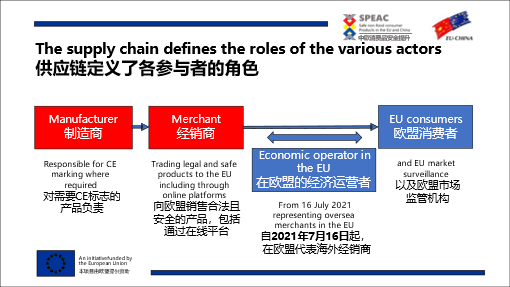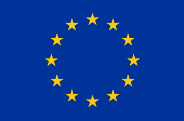
Safe non-food consumer Products in the EU and China
Whilst the manufacturer is the key person when it comes to CE marking, there is still an important role for merchants in ensuring product safety.
The CE mark itself is a self-declaration of the manufacturer that the product is safe and compliant. Only the manufacturer has the right to affix the CE mark.
The diagram below demonstrates the roles of the various actors with the supply chain for a product.

EU law also requires that anyone who exports a product to EU must have a representative physically present in the EU whom the EU authorities can contact, if, for example, the safety of a product is questionable. This EU representative could be the importer, a fulfilment house or another representative authorised by the manufacturer.
Whilst most products sold in the EU are perfectly safe and comply with the EU standards to protect consumers, unfortunately some products that present a serious risk to consumers are found on sale.
The Rapid Alert System (RAPEX) is a joint platform of the EU Member States that publishes products that pose serious risks for consumers. These risks include risks of children choking because of small parts, poisoning with chemicals or electric shocks, to name a few. On the RAPEX system you will find product categories such as toys and electric appliances among the most frequently notified products.
In order to protect consumers, a dangerous product can be banned from the market and the economic operator can be asked to recall all sold products at his own costs. In extreme cases, they can even be requested to destroy the products.
This process can become very expensive, so the economic operator will ask the merchants for financial compensation. On top of this, there can be significant reputational damage for the merchant, the brand, the manufacturer, the sector or even the exporting nation, as issues with product safety quickly become big stories in the European media.
The merchant has an important role to play in ensuring dangerous products are not bought into the EU market as they act like a bridge between the manufacturer and consumers. To meet this important role, merchants should ensure they:
1) Check, if a product bears the CE mark properly together other required information: product name, batch number, manufacturer’s name and address. If a product cannot be physically checked, adequate photographs should be requested.
2) Ask for the product’s Declaration of Conformity (DOC). This is a written statement, and it must be in English or in the language of the product’s destination country.
3) Ask the manufacturer for the product’s Technical File. This file should contain all information that is necessary to prove that a product was made in conformity with all applicable EU rules. Whilst it not the merchant’s responsibility to produce these files, it is important that they ask for them.
The Declaration of Conformity and the technical documentation must be stored for at least 10 years so they can be presented, if any problems arise or the EU authorities ask for it.
Reliable manufacturers will be happy to provide this information when asked for it. A merchant should be concerned if this information is not provided and should consider it a significant risk to their business. In such a situation, a merchant should consider working with a different manufacturer.
You can find further information on CE marking for importers and distributors on the European Commission’s website at https://ec.europa.eu/growth/single-market/ce-marking/importers-and-distributors_en

This website was created and maintained with the financial support of the European Union. Its contents are the sole responsibility of SPEAC project and do not necessarily reflect the views of the European Union.